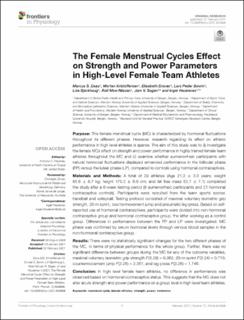| dc.contributor.author | Småvik Dasa, Marcus | |
| dc.contributor.author | Kristoffersen, Morten | |
| dc.contributor.author | Ersvær, Elisabeth | |
| dc.contributor.author | Bovim, Lars Peder Vatshelle | |
| dc.contributor.author | Bjørkhaug, Lise | |
| dc.contributor.author | Moe-Nilssen, Rolf | |
| dc.contributor.author | Sagen, Jørn Vegard | |
| dc.contributor.author | Haukenes, Inger | |
| dc.date.accessioned | 2021-08-25T07:27:37Z | |
| dc.date.available | 2021-08-25T07:27:37Z | |
| dc.date.created | 2021-07-08T11:01:53Z | |
| dc.date.issued | 2021 | |
| dc.identifier.issn | 1664-042X | |
| dc.identifier.uri | https://hdl.handle.net/11250/2771074 | |
| dc.description.abstract | Purpose: The female menstrual cycle (MC) is characterized by hormonal fluctuations throughout its different phases. However, research regarding its effect on athletic performance in high level athletes is sparse. The aim of this study was to (i) investigate the female MCs effect on strength and power performance in highly trained female team athletes throughout the MC and (ii) examine whether eumenorrheic participants with natural hormonal fluctuations displayed enhanced performance in the follicular phase (FP) versus the luteal phase (LP), compared to controls using hormonal contraceptives.
Materials and Methods: A total of 29 athletes (Age 21.2 ± 3.3 years; weight 65.6 ± 8.7 kg; height 170.2 ± 8.0 cm; and fat free mass 52.7 ± 7.1) completed the study after a 6-week testing period (8 eumenorrheic participants and 21 hormonal contraceptive controls). Participants were recruited from the team sports soccer, handball and volleyball. Testing protocol consisted of maximal voluntary isometric grip strength, 20-m sprint, countermovement jump and pneumatic leg-press. Based on self-reported use of hormonal contraceptives, participants were divided into non-hormonal contraceptive group and hormonal contraceptive group, the latter working as a control group. Differences in performance between the FP and LP were investigated. MC phase was confirmed by serum hormonal levels through venous blood samples in the non-hormonal contraceptive group.
Results: There were no statistically significant changes for the two different phases of the MC, in terms of physical performance for the whole group. Further, there was no significant difference between groups during the MC for any of the outcome variables, maximal voluntary isometric grip strength F(3.29) = 0.362; 20-m sprint F(3.24) = 0.710; countermovement jump F(3.26) = 2.361; and leg-press F(3.26) = 1.746.
Conclusion: In high level female team athletes, no difference in performance was observed based on hormonal contraceptive status. This suggests that the MC does not alter acute strength and power performance on a group level in high level team athletes. | en_US |
| dc.language.iso | eng | en_US |
| dc.rights | Navngivelse 4.0 Internasjonal | * |
| dc.rights.uri | http://creativecommons.org/licenses/by/4.0/deed.no | * |
| dc.title | The Female Menstrual Cycles Effect on Strength and Power Parameters in High-Level Female Team Athletes | en_US |
| dc.type | Journal article | en_US |
| dc.type | Peer reviewed | en_US |
| dc.rights.holder | © 2021 Dasa, Kristoffersen, Ersvær, Bovim, Bjørkhaug, Moe-Nilssen, Sagen and Haukenes. | |
| dc.description.version | publishedVersion | en_US |
| cristin.ispublished | true | |
| cristin.fulltext | original | |
| cristin.qualitycode | 1 | |
| dc.identifier.doi | 10.3389/fphys.2021.600668 | |
| dc.identifier.cristin | 1920954 | |
| dc.source.journal | Frontiers in Physiology | en_US |
| dc.source.volume | 12 | en_US |

